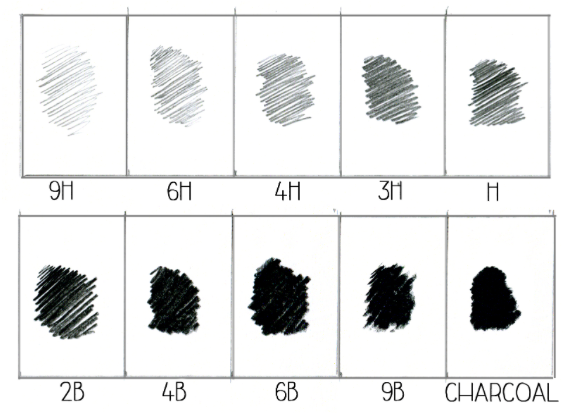Drawing is a crucial skill for nearly every visual artform. Since every artist draws, every artist should have a good working knowledge of the essentials of drawing media. Whether you prefer charcoal over pencil or a vinyl eraser over a kneaded eraser, it’s important to know what’s out there so you can build your ultimate drawing toolkit.
The basics: The pencil

The pencil is the drawing tool no one can live without. It’s versatile, erasable, and cheap, making it the most essential art supply you can own. But there’s more to the pencil than meets the eye– the numbers on the side. They indicate the pencil’s hardness or softness, which is also an indicator of how dark or light the pencil can get. The scale ranges from H (for hard) to B (for soft). The higher the number before the letter, the harder/lighter or softer/darker the pencil is. There are about twenty grades of hardness for drawing pencils, depending on the manufacturer.
Here are 10 examples.

The lighter and harder the pencil, the more erasable. For technical drawing, where precision is most important, lighter pencils are preferable because mistakes are easily corrected.
Other drawing media

There are a few other essential drawing media you should have in your art supply box.
Charcoal: Charcoal comes in two main kinds. Compressed can be quite messy, but is very dark, and with practice, the most versatile. Vine charcoal is literally a charred stick, usually willow, and is a little less permanent-feeling than compressed. Both come in different varieties of darkness and hardness, and compressed also comes in pencil form.
Conte crayon: Conte comes in a range of colors from black and white to sanguine and terracotta. Unlike charcoal, it is an earth-derived material, and a bit harder to correct if mistakes are made, but it lays down a very rich and satisfying tone.
Paper stumps and chamois: These aren’t drawing media per se, but they are useful in blending and evening tones laid down by pencil, charcoal and conte crayon. They can also remove a bit of excess charcoal and conte at times.
Woodless pencil and graphite stick: These are useful in that they are solid graphite, so every stroke leaves a mark and they don’t need to be sharpened, though they can be.
Mechanical pencil: The advantages of a mechanical pencil are that it never needs sharpening and that it consistently lays down a very fine, controllable line. The disadvantage is that dark, soft leads cannot be found in mechanical pencils as they break too easily.
Technical and fountain pens: Technical pens come in a variety of line weights, and fountain pens often have flexible nibs that can also be used to control the width of the line. Both are available with water- soluble and waterproof inks, allowing them to be blended and not with other water-soluble media.
Colored pencils: A wonderful solution for adding color to a drawing even if you’re only comfortable with pencils. Water-soluble colored pencils can become waterolors if washes of water are added.
Other media include markers and chalk and oil pastels, all of which you should at least experiment with.
Erasers and pencil sharpeners

Last but not least, you should avail yourself of the wide variety of erasers and sharpeners out there.
- Pink erasers are good affordable all around erasers for light sketching, though many are familiar with the pink residue they can sometimes leave behind.
- Kneaded erasers have a few interesting qualities: they don’t leave behind any eraser debris, and they can be shaped any way you please. This is especially handy when a small and narrow section of an elaborate drawing needs erasing.
- Gum erasers can be crumbly and imprecise, but they are great for removing large amounts of material without damaging paper.
- Vinyl erasers make precise, clean erasures with little residue, and are good at removing even darker graphite without a lot of smudging and smearing.
Finally, while there are quite a few innovative pencil sharpeners around, there are really only three to consider:
- Electric pencil sharpeners are quick and rarely break the lead of your pencil, but they can be a hassle to lug around, and the battery-powered varieties don’t quite have the punch the plug-in kind do.
- Crank pencil sharpeners are wonderful because they offer a wide variety of sharpening sizes, they’re practically indestructable (the metal kind anyway) and they are also good at keeping your lead unbroken. The disadvantage is that they must be screwed down, and they’re getting harder to find.
- The good old fashioned all-metal hand sharpener is the best for portability and durability. Plastic sharpeners break easily, but the metal ones give you the best bang for your buck, even if you still need to be careful not to break your lead!

Really I learned more and more of what I needed. Watercolor pencils, graphite pencils...I learned that the best paper is essential...especially for mixed media. I have to purchase the best which I do not think I have...